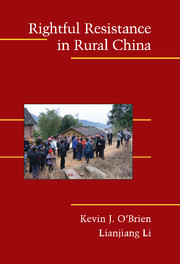Book contents
- Frontmatter
- Contents
- Preface
- Rightful Resistance in Rural China
- 1 RIGHTFUL RESISTANCE
- 2 OPPORTUNITIES AND PERCEPTIONS
- 3 BOUNDARY-SPANNING CLAIMS
- 4 TACTICAL ESCALATION
- 5 OUTCOMES
- 6 IMPLICATIONS FOR CHINA
- Interviewee List
- Appendix A Who Leads Rightful Resistance?
- Appendix B Sources
- Bibliography
- Index
- References
Bibliography
Published online by Cambridge University Press: 05 September 2012
- Frontmatter
- Contents
- Preface
- Rightful Resistance in Rural China
- 1 RIGHTFUL RESISTANCE
- 2 OPPORTUNITIES AND PERCEPTIONS
- 3 BOUNDARY-SPANNING CLAIMS
- 4 TACTICAL ESCALATION
- 5 OUTCOMES
- 6 IMPLICATIONS FOR CHINA
- Interviewee List
- Appendix A Who Leads Rightful Resistance?
- Appendix B Sources
- Bibliography
- Index
- References
Summary

- Type
- Chapter
- Information
- Rightful Resistance in Rural China , pp. 143 - 168Publisher: Cambridge University PressPrint publication year: 2006

